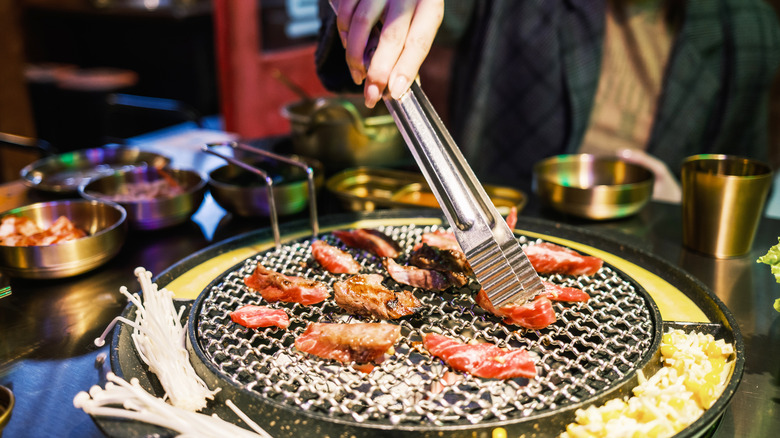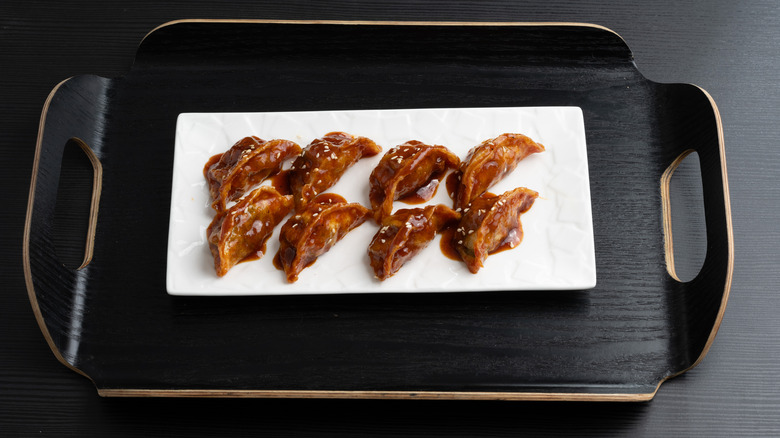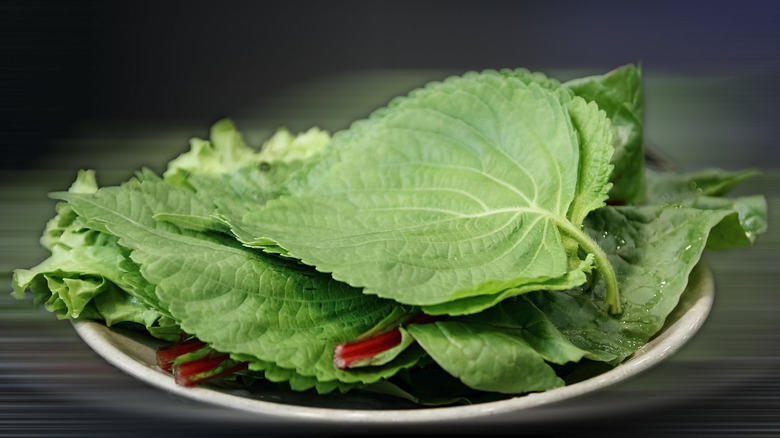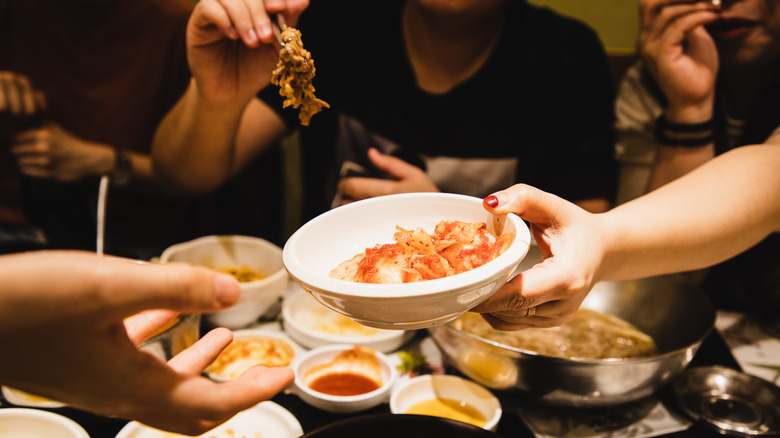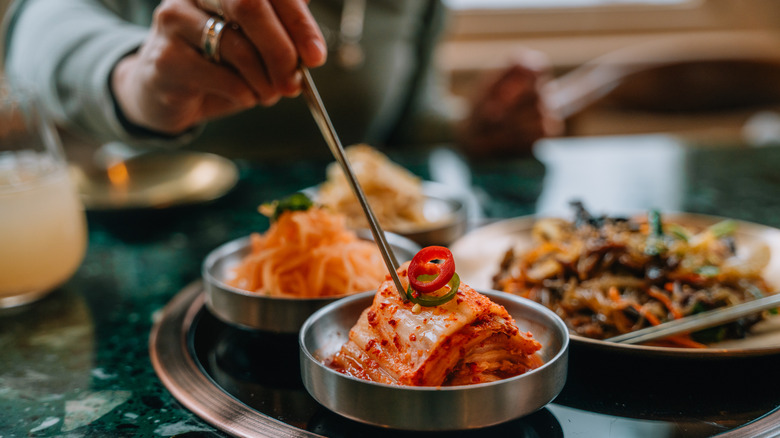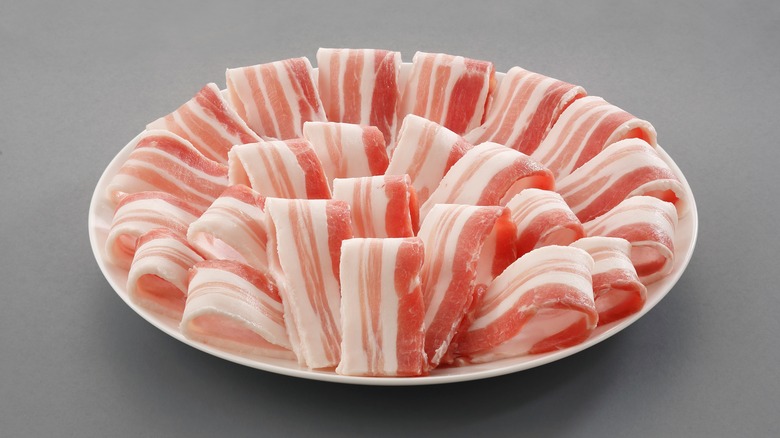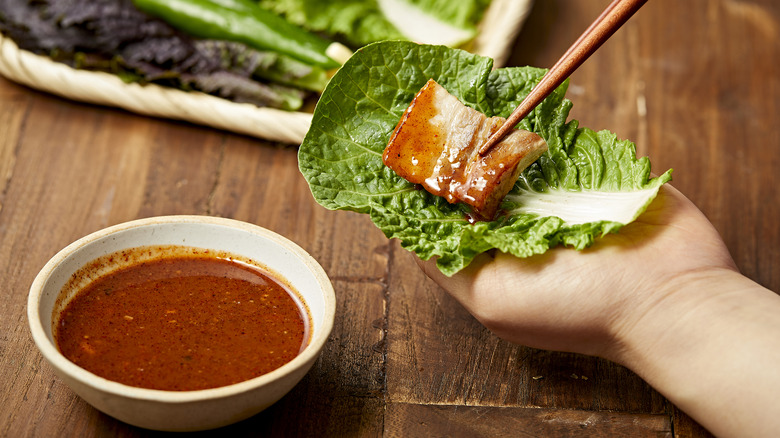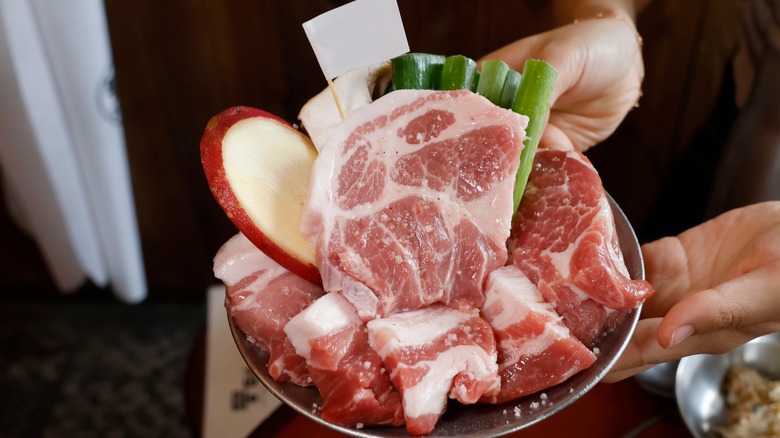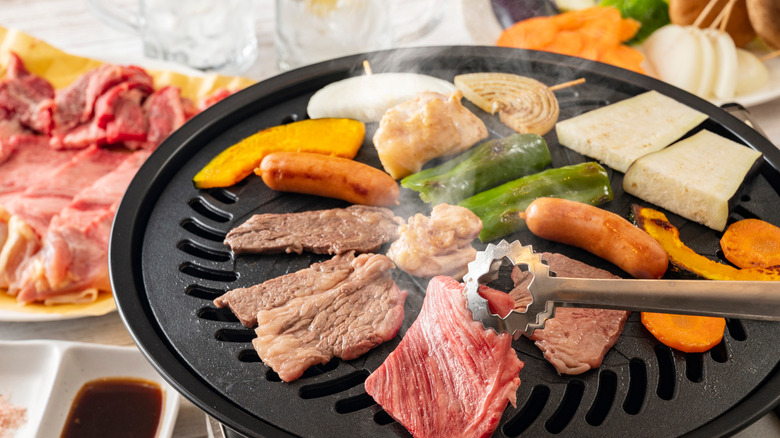9 Mistakes You're Making When Eating At A Korean BBQ Restaurant
You may have driven past the beaconing neon signs announcing Korean barbecue (aka K-BBQ), or perhaps you've even experienced firsthand the collective joys of sitting around an active grill inside one of these establishments. The kaleidoscopic options listed on laminated menus (things can get messy) can be both exciting and intimidating — and will surely require at least a little know-how before you can start ordering. I've learned to master my order and K-BBQ etiquette over the years and I'm here to offer you some pointers to move your needle past novice and to help give you a leg-up at the table.
For another perspective on how to master Korean barbecue and all its moving parts — including live flames, in-table grills, plates of raw meat, rolling carts of banchan — I spoke with Han Hwang, chef and owner of Portland's immensely popular Kim Jong Grillin' and champion of Food Network's third season of "The Great Food Truck Race." As an expert on Korean barbecue within his kitchen, as well as while out-to-dinner with friends, Han admits, "There has never been a time where I'm not cooking at [Korean barbecue]. People will just look at me until I have to grab the scissors or the tongs."
Neglecting to do your homework
Just because you have a few Korean dishes in your culinary quiver doesn't mean you need to send each of them to your server every time you enter a Korean barbecue restaurant. Remember, Korea is an entire country with countless regional cuisines and variations in cooking styles; you just sat down at one particular restaurant with their unique team helming the kitchen. The best thing that you can do here is to do your research ahead of time to see what a restaurant specializes in and what might be of interest to you as a diner.
Before I visit a spot, I'll stalk the establishment's Instagram geotag and sort the list by recent and/or popular posts. If a dish repeatedly appears and looks enticing, I'll order it. On the other hand, if I walk through the door craving dumplings (or mandu in Korean), and I stumble onto multiple pictures of dry, sad-looking dumplings on the menu, I'll call an audible and reassess my order. Moreover, unless I see a tempting photo posted online of a dish that I consider outside of the realm of Korean barbecue, I'll stick to the restaurant's core menu.
Not ordering the lettuces
While the meat at most Korean barbecue stands on its own, part of the experience is being able to assemble your own handheld wraps called ssam. The joy of messily stacking rice, crunchy daikon, kimchi, and meat into the palm of a lettuce-laced hand bestows a ritualistic tact to the meal. However, I often observe that other tables do not order greens for their tables.
Recently, and likely thanks to the inflated prices of food items, I've noticed all my go-to Korean barbecue spots now defer to listing the ssam – which might include fresh lettuces, perilla, nasturtium, rice paper, and pickled daikon — as an extra. Depending on the menu and restaurant, you may find the ssam in the section with the extra rice and add-on items. I would still recommend ordering these with your meal. They allow you to create balance, texture, and dimension with every bite.
Selecting a low-quality restaurant
Korean restaurants often span far beyond the scope of K-BBQ. But, I've found many of establishments will offer a barbecue experience too (likely due to the meal's popularity), despite it not being their focal point. For example, the spot I grab my Korean black bean noodles (jjajangmyeon) differs from where I take my friends for a celebratory barbecue night. So just searching "Korean barbecue" in your phone's map app won't always deliver the best meal options. Instead, keep your eyes peeled for signifiers pointing to a high-quality Korean barbecue joint.
Firstly, make sure the dining room is equipped with grills on every table — this ensures that the space is well-outfitted to serve K-BBQ to its guests. As a kind of dinnertime "Where's Waldo?" you can also look for Jinro toad, a chubby charmer cuter than even Moo Deng. Jinro, one of Korea's largest soju manufacturers, offers this mascot to businesses as a token of thanks for selling its product. When I scope out an 8-inch tall, toad-shaped doll (in green, blue, or pink) at a Korean barbecue place, I know I'm seconds away from sipping on my favorite soju brands. The toad is also a signifier that the restaurant has sold a ton of this alcoholic beverage and that it pays just as much attention to its beverage selection as it does its barbecue.
Going as a two-top
Some meals are meant for a romantic, intimate table for two — and others are meant to be shared with hands and chopsticks crossing the tablescape throughout the evening. Like Chinese dim sum, the best Korean barbecue nights often feature at least three (hungry) participants. Chef Han Hwang agrees; he says that one of the common mistakes he sees folks making with Korean barbecue is that they don't understand that it's served family-style.
When you are ordering for extra mouths, you can order more meats and combinations. For example, you can stick to ordering the standard items on the tabletop grill — like pork and beef — and tackle some more creative options like Korean mackerel and shrimp. These supporting proteins can really elevate your dining experience and offer surf and turf opportunities you may not otherwise get if you're only eating for two. Plus, so many of the ancillary dishes, like pajeon (a variety of savory pancake), mandu, and ddukbokki, are available to order and can be split across multiple people. This can really make sending out those extra invites worth it.
Not asking for more banchan
Even if you don't pick an all-you-can-eat Korean barbecue spot, your banchan, or Korean small plates, are often replenishable. Bachan — including kimchi, wilted bean sprouts, and cucumber — are intended to be munched on immediately; servers usually drop the small dishes shortly after a table decides on their meat order. But, you should avoid eating them as soon as they arrive, as they're meant to act as a crunchy intermission between the bits of salty meat — like a pickle plate. Plus, you can also include bits of banchan into your ssam for texture.
But once your table finishes any individual banchan (which rotate often and are specific to the restaurant itself), your server will check in with the crowd and offer a refresher. Fear not, you're not being up-sold and you won't be seen as rude or demanding if you request more bachan. Refills are a customary feature of the meal, and your server is simply checking in. So, nibble to your heart's content, save a little banchan for your wraps, and ask for what you need, because another helping is just steps away.
Not ordering pork belly
Somewhere along the way, galbi, or Korean ribs, became emblematic of the entire Korean barbecue experience. And while I'll never skimp on the sweet and salty beef, I also refuse to pass up an opportunity to relish slices of pork belly (samgyeopsal-gui) in company with my steak.
Pork belly is fattier, milder in flavor, and cooks faster than the sweetly marinated galbi. It's an indulgent protein that eliminates the need to order more extravagant proteins like Wagyu or beef tongue. The meat can be further elevated with a generous dunk of sesame oil and a sprinkle of salt. Han Hwang agrees. "I love the simplicity of the combination of sesame oil, salt, and pepper." In symphony with sesame oil, the uncluttered bites of pure fat and salt elevate a Korean barbecue night to great heights. Just don't forget to pull your pork off the grill after it starts shrinking. Otherwise, the fatty meat will seize up and lose its flavor and texture.
Forgetting to use sauce
An integral aspect of Korean barbecue lies in experimenting with various combinations of flavors on the table, finding your way, and learning what you like best at each establishment. And, there's no better way to experiment with meats at a Korean barbecue spot than trying all of the different sauces, which are often served in a triptych of slots.
The sauce trio you'll often encounter at a Korean barbecue joint includes a fermented soybean and Korean gochujang concoction called ssamjang, a sesame and salt mixture (gireumjang), and a wasabi and soy concoction for heat. These sauces offer spice, umami, and depth and can really elevate your proteins. I prefer ssamjang over the rest, but I also like watching fellow diners experiment with these sauces and discover their condiment of choice.
Deferring to all-you-can-eat buffets
Unless your party contains at least two members who can eat their weight in meat, there's no reason to visit an all-you-can-eat Korean barbecue buffet. For me, the value of any meal should never be on how much food the restaurant serves — it should be on the quality. You can learn about the portion sizes before you visit a restaurant by doing your research ahead of time. If you must experience the adventure of an unlimited buffet, armor yourself with a group prepared to leave uncomfortably full. Han Hwang even recommends folks eat "no less than 6 pounds of meat per four people in the party."
Many buffet-style Korean barbecue restaurants will prohibit to-go boxes, so unless you are sure your party can plow through a second helping of meats, relish the freedom of over-ordering and being allowed a doggie bag. That doesn't mean you won't be satisfied if you opt for plates of meat and à la carte barbecue; these items have never once appeared paltry, even when I'm at my most hungry.
Never attempting it at home
Making Korean barbecue at home may appear intimidating at first, but it's worth the barrier to entry. It accelerates your ability to become a Korean barbecue virtuoso and allows you to host friends for a soju-soaked night. Wander into your local Korean or Asian grocery and go to the housewares section. You'll find circular and rectangular grills made to rest atop of a laptop-sized butane burner.
After grabbing these two items, you'll only have to worry about replenishing the butane ahead of your big night-in. At the same market, you'll likely find pre-cut Korean ribs and pork belly ready for you to marinate and cook elbow-to-elbow with your loved ones. And like any good dinner party, simply request your guests to provide one or two banchan to fill out the tablescape.
Han Hwang shared some tips for cooking those grilling at home. "Let the meats cook when they are supposed to," he says. "Oh, and also be confident in knowing that the fire will cook the meat."
